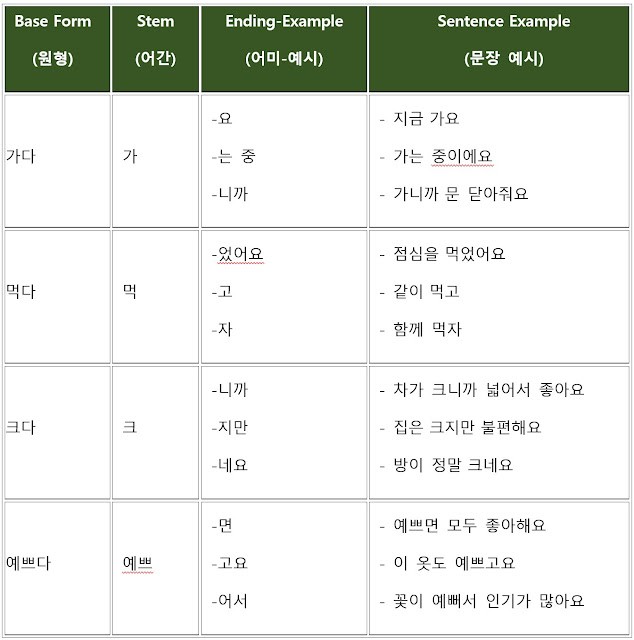TL;DR – Endings are Everything.
In Korean, it’s not just what you say—it’s how you end it. From declaring facts to asking questions or showing respect, verb and adjective endings (어미) carry the full weight of grammar and tone.
Learn to wield them, and you’ll unlock fluency.
1. What is an “어미”?
In Korean, “어미” refers to the grammatical element attached to the end of a verb or adjective stem.
At first glance, it may resemble English tense changes, but in reality, Korean endings serve a much broader range of functions.
For example, the speaker’s intention (declarative, interrogative, imperative, etc.), tense (past, present, future), honorific level, and even how clauses are connected—all are expressed through endings.
2. Why Learning Endings Matter
When you understand and can fluently use verb endings, your ability to construct Korean sentences improves dramatically.
You’ll also be able to express feelings, attitudes, and nuances that mere vocabulary memorization can’t capture.
3. The Difference Between “어간” and “어미”
Before diving into endings, it’s essential to understand the distinction between 어간 (stem) and 어미 (ending).
– “Stem (어간)” is the part of the word that carries its core meaning.
– “Endings (어미)” is added to the stem to express grammatical information.
Let’s Take a Look at Some Real Examples of Verbs and Adjectives:

As shown above, the stem carries the core meaning of a word, while the ending determines how that meaning is expressed in a sentence.
FAQ (Frequently Asked Questions)
Q1. Are Korean verb endings the same as English tense markers?
A1. No. Korean endings express tense, mood, politeness, and sentence type—all at once.
Q2. Why are there so many types of endings?
A2. Because Korean relies on endings to carry most grammatical meaning instead of word order or auxiliary verbs.
Q3. How can I tell what’s a stem and what’s an ending?
A3. The stem contains the meaning, and the ending tells how it's used. We’ll cover how to separate them in the next post!
4. Types of Verb and Adjective Endings in Korean
Korean verb and adjective endings can be broadly classified into three main categories. Each type plays a different role in sentence structure and is essential for learners to master expressions ranging from basic to advanced.
4-1. Classification by Position
① Pre-final endings (선어말어미): These come before the final ending.
– Function: Tense, modality, honorifics
📌 Examples: “-았/었-“, “-겠-“, “-시-“
📌 Example Sentences:
- “어제 친구 집에 갔어요.” I went to my friend’s house yesterday.
- “내일 가겠습니다.” I will go tomorrow.
- “어머니께서 지금 가십니다.” Mother is going now.
② Final endings (어말어미): These appear at the end of a sentence.
– Function: Sentence-ending functions like declarative, imperative, suggestive, and exclamatory
📌 Examples: “-요,” “-습니다,” “-니까,” “-자,” “-네”
📌 Example Sentences:
- “지금 가요.” I’m going now.
- “이거 맛있습니다.” This is delicious.
- “안녕하십니까?” Hello.
- “같이 하자.” Let’s do it together.
- “옷이 예쁘네요.” The clothes are pretty.
4-2. Classification by Function
① Connective endings (연결어미): Used to link clauses
– Function: Reason, condition, time, contrast, etc.
📌 Examples: “-고,” “-지만,” “-아서/어서,” “-는데,” “-니까”
📌 Example Sentences:
- “밥을 먹고 집에 갑니다.” I eat and then go home.
- “이건 예쁘지만 비싸요.” This is pretty but expensive.
- “졸려서 꾸벅꾸벅 졸았어.” I was sleepy and kept nodding off.
- “맛있는데 배가 너무 불러서 못 먹겠어요.” It’s delicious, but I’m too full to eat more.
- “비가 오니까 우산 챙기세요.” Since it’s raining, take an umbrella.
② Sentence-final endings (종결어미): Used to end sentences
– Function: Declarative, interrogative, imperative, suggestive, etc.
📌 Examples: “-다,” “-나, -니,” “-라,” “-아/어라,” “-자, -아/어요”
📌 Example Sentences:
- “나는 집에 간다.” I go home.
- “너도 학교에 가니?” Are you going to school too?
- “지금 당장 가라!” Go right now!
- “우리 같이 가자.” Let’s go together.
- “저 지금 가요.” I’m going now.
③ Transformative endings (전성어미): Used to convert verbs/adjectives into other parts of speech
– Function: Turns verbs/adjectives into nouns, modifiers, or adverbs
📌 Examples: “-기,” “-ㄴ,” “-게”
📌 Example Sentences:
- “여행하기 좋아요.” Noun form. Traveling is nice.
- “예쁜 꽃이 피었다.” Adjective form. A pretty flower bloomed.
- “예쁘게 꽃이 피었다.” Adverb form. The flower bloomed beautifully.
4-3. Classification by Phonological Features
① Consonant endings (자음어미): Appear consistently regardless of stem ending
📌 Examples: “-고,” “-게,” “-지”
📌 Example Sentences:
- “집에 갔고, 밥을 먹었어요.” I went home and had a meal.
- “일찍 가게 준비해 주세요.” Please prepare so I can leave early.
- “너도 같이 가지?” You’re coming too.
🐾 Consonant-initial endings are applied directly without any changes to the stem.
② Vowel endings (모음어미): Change form depending on whether the stem ends in a bright or dark vowel
📌 Examples: “-아/어,” “-았/었”
📌 Example Sentences:
- “지금 가.” Go now. → “가” + “-아”
- “어제 갔어.” I went yesterday. → “가” + “-았”
- “밥 먹어.” Eat your food. → “먹” + “-어”
- “점심 먹었어.” I ate lunch. → “먹” + “-었”
🐾 In Korean vowel harmony, when an ending starts with a vowel, its vowel changes to match the quality of the final vowel in the stem—bright vowels pair with bright endings, and dark vowels pair with dark endings.
③ Euphonic endings (매개모음어미): Add “으” if the stem ends in a consonant; omit it if the stem ends in a vowel
📌 Examples: “-(으)니,” “-(으)ㄴ”
📌 Example Sentences:
- “책을 읽으니 재미있어요.” Reading the book is fun. → “읽” + “-으니”
- “지금 가니?” Are you going now? → “가” + “-니”
- “내가 닫은 문이야.” It’s the door I closed. → “닫” + “-은”
- “온 사람이 누구예요?” Who’s the person who came? → “오” + “-ㄴ”
5. Learning Focus and Post Sequence
Endings are not just suffixes—they are the core of Korean grammar and the key to expanding expressive power.
Whether you’re a beginner or an advanced learner, studying verb endings will elevate your Korean, both in grammar and in conversation.
Blog Post Sequence
– Definition and Classification of Verb Endings
– Practice: Distinguishing Between Stems and Endings
– Final Endings (어말어미)
– Pre-final Endings (선어말어미)
– Sentence-Final Endings (종결어미)
– Connective Endings (연결어미)
– Connective Endings: 100+ Quiz Questions for Real-Life Practice
– Transformative Endings (전성어미)
Korean endings go far beyond one post.
Each type of 어미 brings its own role—whether it finishes a sentence, connects ideas, adds formality, or transforms meaning.
This post is just one part of a broader journey.
Keep exploring the many kinds of Korean verb and adjective endings through the posts below.
▶ Practice Stems vs Endings
▶ Final Endings (어말어미)
▶ Pre-final Endings (선어말어미)
▶ Sentence-Final Endings (종결어미)
▶ Connective Endings (연결어미)
▶ Connective Endings: 100+ Quiz Questions
▶ Transformative Endings (전성어미)
#KoreanGrammar #Eomi #VerbEndings #LearnKorean #StudyKorean #KoreanLanguage #KoreanFluency #SentenceStructure #PolitenessLevels #LanguageTips


